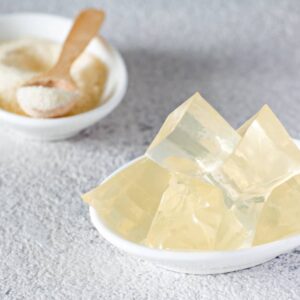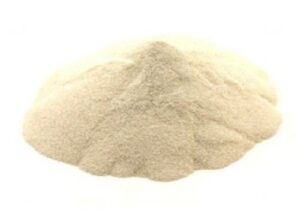Cooking is more than an art or a science. On the one hand, to prepare a really tasty dish, you need to use strictly defined elements in the specified proportions. On the other hand, there is always some freedom of action, and some constituent element can be replaced by another.
And that is why cooking some dishes is difficult. For example, if you want to gel a product, then which thickener is better to use — gelatin, agar-agar, or even some kind of pectin? And what is the difference between these ingredients, why are they not always completely interchangeable?
In this material, we will figure out what is the difference between gelatin and agar-agar — and what is better to use when preparing certain dishes.
Gelatin

Gelatin is a gelling agent of animal origin. That is, when dissolved in a liquid, it acquires a gel-like texture, due to which it can hold volume. As a result, it can be used to make jellies, jellies and similar products.
However, the intensity of the manifested gelling properties directly depends on the concentration of gelatin in the product. For example, if added in limited quantities, it can act as a thickener. To this end, it is used in sauces, puddings, and sometimes baked goods.
Gelatin is an animal product. It is obtained from the skins, bones and tendons of cattle. In fact, it is almost pure protein — up to 98% of the mass is occupied by protein compounds. In principle, this is why gelatin “melts” at a high, but not excessive temperature, and freezes only in the cold.
Excellent gelling properties make gelatin an almost universal product. It can be used to prepare a wide variety of dishes with a characteristic “melting” texture and voluminous texture. In addition, in dissolved form, it is completely transparent.
However, gelatin is also not without drawbacks. First, it has a slight aftertaste. Therefore, it is definitely not recommended to add it to products in large quantities. So, with an overabundance of this ingredient, the finished dish acquires a characteristic, not too pleasant “meat” aftertaste.
Secondly, if a really thick and hard consistency is required — for example, when preparing marmalade from fruit juices — then gelatin simply cannot cope with this. It thickens to about the same level regardless of the amount. Of course, you can try to evaporate the product at an average temperature — but why, when there are other thickeners?
So, let’s sum up.
Advantages
-
- Able to make light and airy jelly even from liquid products;
-
- It is used in the preparation of a huge number of dishes;
-
- Easily available, found in any grocery store, low price.
Flaws
-
- Not suitable for vegetarian dishes;
-
- It has a characteristic aftertaste, which can appear with an overabundance of the ingredient;
-
- Not suitable for strong thickening products.
It is also worth noting that gelatin dissolves at high temperatures, and thickens at low temperatures. There, the optimum pour point is up to +4 degrees. Under room conditions, it will “capture” for a very long time and not very effectively.
Therefore, it is not suitable for cooking dishes that cannot be cooled, for example due to “separation” due to low temperatures.
agar agar

Agar-agar is a plant based thickener. With it, you can achieve both a light and airy texture, and a very dense one. For example, both marshmallows for “Bird’s Milk” cakes and rather dense and hard marmalade from natural juices are prepared with the addition of agar-agar.
The texture of the finished dish depends on several factors, and the amount of thickener added is just one of them. The temperature and method of preparation is also important. Agar-agar “seizes” quite quickly, so with the same consistency of it, you can get both an airy soufflé and a rather elastic marshmallow.
Agar-agar is a product of completely plant origin. It is obtained from seaweed. Therefore, it is suitable for vegetarian and vegan diets, and in terms of nutritional value, it is almost completely (95%) a carbohydrate. And complex, “starch type.”
Agar-agar is the most versatile. It is added to any dishes, the consistency of which needs to be made thicker. It is used in sweets, pastries, soups, sauces, even some meat, vegetable and fish dishes. It can also be used for gelling — and you can achieve both a “trembling” and “elastic” consistency. However, this component is rarely used in jelly, since the finished dish does not hold its shape well, can fall apart or deform even when serving, and is also opaque.
The fact is that agar-agar itself is opaque. And when cooking, it makes the solution rather “cloudy”. As a result, transparent dishes — jellies, aspics, jellies — based on this ingredient are not very beautiful.
So, let’s sum up.
Advantages
-
- Allows you to easily “manage the consistency”;
-
- Suitable for vegetarian food;
-
- It can be used not only as a gelling agent, but also as a thickener.
Flaws
-
- Poorly suited for creating jellies, jellies and aspics;
-
- It is expensive and rarely found in stores.
Agar-agar has another important advantage — it thickens already at 40 degrees. That is, the dish “seizes” at room temperature, you do not have to put it in the refrigerator. True, it is required to dissolve agar-agar in hot, and even better, boiling water. Gelatin is more practical in this regard.
Which is better — gelatin or agar-agar?

So, gelatin is a gelling agent, and agar-agar is a thickener. However, both of them are still suitable for making jelly. But the difference between these ingredients is more significant than it seems.
|
Characteristic
|
Gelatin
|
agar agar |
|
Origin |
Animal |
vegetable |
|
The nutritional value |
Up to 98% proteins |
Up to 95% complex carbohydrates |
|
purpose |
Gelling component |
Thickener |
|
Consistency of the finished dish |
Mostly jelly-like, gelatinous |
Depends on the cooking method — from thick to elastic or even tough |
|
Color |
Transparent |
Opaque |
|
Taste |
There is a characteristic taste |
Tasteless |
|
Dissolution temperature |
room |
From +80 degrees |
|
Thickening temperature |
About +4…+10 degrees |
room |
|
Is it possible to cook something “melt in your mouth” |
Yes Easy |
No, the texture will either be watery or bouncy |
|
Is it possible to cook something “hard” and very elastic, like marmalade |
Difficult |
Yes, it is enough to add more component |
|
Release form |
Crystals, plates |
Powder, plates |
|
Availability and price |
Found everywhere, inexpensive |
Rare, more expensive |
In general, gelatin and agar-agar can act as an alternative to each other. But there are some dishes in which they cannot be replaced. For example, in “trembling”, tender jelly, in transparent jelly or aspic, it is recommended to use gelatin. But in sauces, souffles, marshmallows, marshmallows, marmalade and some other products, it is better to use agar-agar.
And, of course, gelatin is not suitable for vegetarians.

Добавить комментарий
Для отправки комментария вам необходимо авторизоваться.